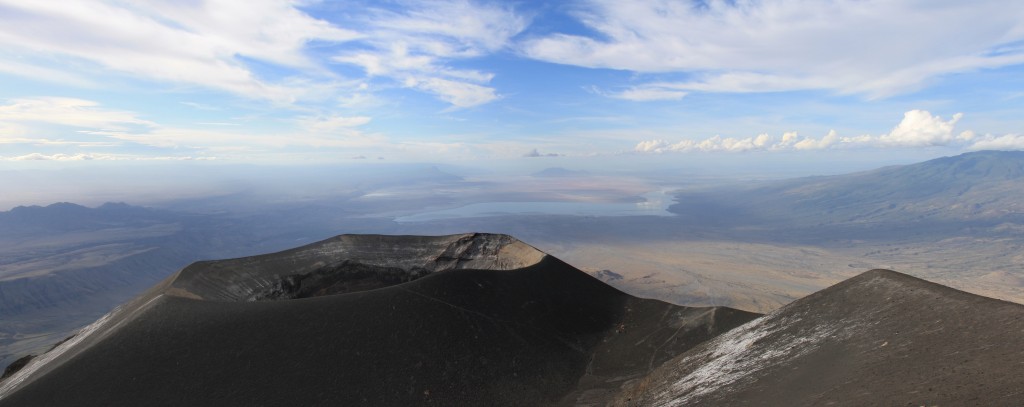
“Oldoinyo Lengai summit view” by Jaap Berghuijs, distributed by the European Geosciences Union under a Creative Commons license
Natural Geographic describes Ol Donyo Lengai (pronounced ol doyn-yo len-guy), a mountain in northern Tanzania, as the ‘strangest volcano on Earth’. It is the planet’s only volcano known to produce lava made of natrocarbonatite, chemically similar to laundry soap, which hardens and decays almost immediately upon exposure to the atmosphere. It is very rare for natrocarbonatite, a type of igneous rock rich in carbonates such as calcite and dolomite, to reach Earth’s surface in such a pure state, as it usually appears intruded within other formations.
The natrocarbonatite lava erupts at around 538°C, roughly half as hot as the more common basalt lavas. Incredibly, the lava, liquid as it is extruded from the volcano, hits the ground as a solid, with the sound of breaking glass. In just a few days, it turns from black to brown to gray and, finally, to a frosty white, indicating it is fully decomposed.
Earth scientist Jaap Berghuijs took this impressive picture from the summit of Ol Donyo Lengai. He describes the mountain, “Lengai is a very active volcano that last violently erupted in 2007-2008 from its southern crater, which is shown in the center of this picture. It was only about a century ago that someone first climbed the volcano, as the area is very remote and the local Masai consider the mountain sacred. Its white slopes, shown in the foreground of the image, were therefore long thought to be a snowcap similar to that of the nearby Kilimanjaro but actually consist of a variety of weathered carbonate minerals. It was a tough climb to get to the top, as the outer slopes of the volcano are covered with ash and very steep – up to 40°. As our Masai guides put it: ‘Two steps become one’ – which seems funny until you have tried to climb but slid down again just too often. It was well worth the effort though, the view on the 400m tall rift escarpment (left background), Lake Natron (centre background) and many central, and smaller, monogenetic volcanoes (such as the shield volcano Gelai, right background) is just stunning. We spent a month in the area doing volcanological research on Lengai itself and the smaller volcanic edifices around it. Our 24-hour stay on Lengai’s summit (notice our tents right below the crater rim, which also gives an idea of the scale in this picture) definitely was the highlight of our expedition.”
The viewing area covered by the photo is striking, produced using a special panoramic technique and plenty of patience. Berghuijs explains, “The picture is a composite of three images, shot with a Canon EOS 1000D, 18 mm Sigma lens, ISO 100, shutter speed 1/200, f-stop 9.0. It took me about an hour of waiting at the summit before a window in the clouds briefly allowed a clear view of the background.”
Ol Donyo Lengai, Masai for ‘Mountain of God’, is 2,332m in height and is the home of Eng’ai, the Masai god for rain, cattle, and children. A short but stunning documentary on this magical mountain, presented by volcanologist Guy de Saint Cyr, can be viewed here.
Imaggeo is the EGU’s online open access geosciences image repository. All geoscientists (and others) can submit their images to this repository and since it is open access, these photos can be used by scientists for their presentations or publications as well as by the press and public for educational purposes and otherwise. If you submit your images to Imaggeo, you retain full rights of use, since they are licensed and distributed by the EGU under a Creative Commons licence.
